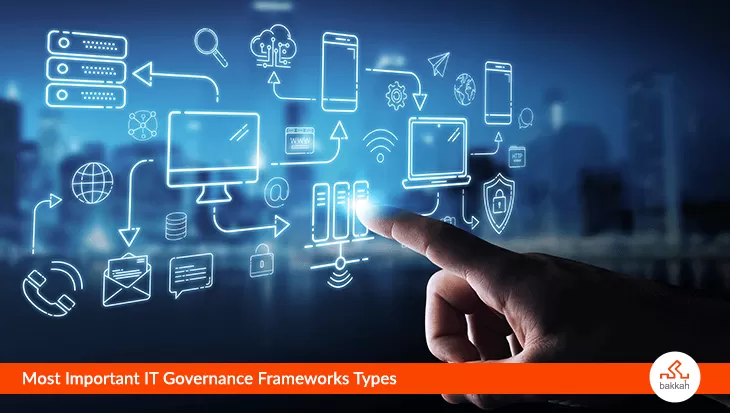IT Governance and Service Management
IT Governance And The Top 11 IT Governance Frameworks
Last Updated: Jul 2025
What is IT Governance?
IT Governance refers to the set of processes, policies, and procedures that are used in businesses to ensure that an organization's IT (Information Technology) systems and infrastructures are aligned with the Business's goals and objectives i.e. Mission and vision.
The Process of IT Governance involves the management of IT resources, risks, and performance for the purposes above. It is crucial for modern business management because organizations rely on technology in operation which led to risks and challenges related to cybersecurity, data privacy, regulatory compliance, and other issues.
IT Governance typically includes several key components: Strategic alignment, Risk management, Performance measurement, Compliance, and Resource management. Effective IT Governance can help organizations manage their IT systems and infrastructure more efficiently and effectively, reduce risk, and enhance their overall performance and competitiveness.
IT governance is an important component of corporate governance, which aims to improve IT management and benefit from investment in information technology. IT governance frameworks enable organizations to effectively manage information technology risks in order to ensure that information technology management work is aligned with organizational goals.
What are IT Governance Frameworks?
IT Governance Frameworks are structured sets of guidelines, best practices, and standards that organizations can use to design, implement, and manage effective IT Governance. These frameworks help organizations ensure that their IT strategies align with business objectives, manage risks, optimize resources, and deliver value. Some of the prominent IT Governance Frameworks include:
IT Governance Framework is the way to identify a specific IT governance way of implementation to help organizations provide a plan for evaluating the performance and effectiveness of their IT governance processes. It provides insight into the performance of the IT department and clarifies the legal and regulatory procedures required for IT.
Organizations often choose a combination of frameworks based on their specific needs, industry regulations, and the nature of their IT operations. Implementing an IT Governance Framework helps organizations establish a systematic and structured approach to managing IT, fostering transparency, accountability, and the efficient use of resources.
IT governance framework helps to:
- Clarify IT operations.
- Statement of inputs and outputs of operations.
- Clarify the main process objectives.
- Explanation of performance measurement techniques.

Top 8 IT Governance Frameworks:
The top 8 IT Governance Frameworks include COBIT (Control Objectives for Information and Related Technologies), ITIL (Information Technology Infrastructure Library), ISO/IEC 38500, the NIST Cybersecurity Framework, TOGAF (The Open Group Architecture Framework), PRINCE2 (PRojects IN Controlled Environments), CMMI (Capability Maturity Model Integration), and the NIST Risk Management Framework. Organizations often select and integrate these frameworks based on their specific needs, industry requirements, and the nature of their IT landscape.
Here are the well-known IT governance frameworks for companies and corporates:
1. ITIL Framework For IT Governance
ITIL framework, developed by Axelos, is the most popular and widely used IT Service Management (ITSM) framework, and its latest version, ITIL 4, was released in February 2019. ITIL is backed by ISO/IEC 20000:2011, which is the international standard for ITSM based on which organizations can obtain independent certification.
ITIL Governance Framework covers important ITSM areas such as:
- Service strategy, design, transition, operation, and improvement.
- Problems management.
- Accident Management.
- IT Change Management
The ITIL framework is widely used to be created by default on many ITSM platforms.
2. COBIT Governance Framework
COBIT Framework is one of the top IT Governance frameworks that can be defined as an internationally recognized IT governance control framework that helps organizations meet business challenges in regulatory compliance, and risk management and align their strategy with regulatory objectives.
The latest version of this framework is COBIT 2019, which was released in November 2018 and is based on COBIT 5, introducing new concepts and addressing the latest developments affecting enterprise IT. Developed by ISACA, the COBIT framework is compatible with other common frameworks, such as CMMI and ITIL.
The COBIT framework focuses on several key areas:
- Protection.
- Risk Management.
- Information Management.
COBIT is a high-level tool that can be used to develop and customize policies, procedures, and processes. It is not designed for low-level management, so it is useful to resort to other tools for those departments, such as ITIL.
3. NIST Cybersecurity Framework:
The National Institute of Standards and Technology (NIST) Cybersecurity Framework is a set of guidelines, standards, and best practices designed to help organizations manage and improve their cybersecurity posture. Developed by NIST, the framework provides a common language for organizations to understand, manage, and communicate cybersecurity risk. It was first introduced in 2014 and has since become widely adopted across various industries.
The NIST Cybersecurity Framework is flexible and scalable, making it applicable to organizations of various sizes and industries. It is particularly useful for establishing or improving a cybersecurity program, enhancing risk management practices, and fostering communication about cybersecurity risk across an organization. While it is not a one-size-fits-all solution, the framework provides a valuable structure for organizations to develop and maintain effective cybersecurity practices.
4. TOGAF (The Open Group Architecture Framework):
The Open Group Architecture Framework (TOGAF) is a widely used enterprise architecture methodology and framework. Developed and maintained by The Open Group, TOGAF provides a set of best practices and guidelines for designing, implementing, and managing enterprise architecture. It offers a structured approach to organizing and governing an organization's IT infrastructure and overall business processes.
TOGAF is widely used by organizations to improve their business efficiency, align IT with business goals, and ensure that enterprise architecture activities contribute to overall strategic objectives. It is a comprehensive and flexible framework that can be adapted to various industries and organizational structures.
5. VAL IT Governance Framework
VAL IT is an IT governance framework developed by the Institute of Information Technology Governance (ISACA). VAL IT expands and complements COBIT by providing a comprehensive control framework for IT governance.
However, the main difference between the two frameworks is that VALIT focuses on investment decisions and expected profits. On the other hand, COBIT focuses on the implementation area, for example, whether is it done the right way.
For management to be effective, it should be supported by senior management, however, leadership support is not enough. VAL IT supports senior management by providing a comprehensive framework supported by processes and other guidance materials to help management executives understand, discuss and evaluate IT-backed business investments.
6. AS8015-2005 IT Governance Framework:
AS8015-2005 is a specific IT Governance framework developed in Australia. Published in 2005, this framework consists of a concise 12-page document outlining six principles aimed at guiding effective IT management. While the specific details of the framework may not be elaborated here due to its brevity.
AS8015-2005 IT Governance Framework typically focuses on principles related to strategic alignment, risk management, resource optimization, performance measurement, compliance, and effective communication within the context of IT governance. Organizations in Australia and beyond may consider AS8015-2005 as part of their IT governance initiatives to ensure that IT activities align with business objectives and deliver value while managing associated risks.
7. PRINCE2 (PRojects IN Controlled Environments)
PRINCE2 (PRojects IN Controlled Environments) is a project management framework, and while it is not specifically an IT Governance framework, it includes principles and practices that can contribute to the effective governance of IT projects. PRINCE2 provides a structured approach for managing projects, ensuring they are well-controlled, organized, and deliver the desired outcomes.
While PRINCE2 itself does not cover the full spectrum of IT governance (which involves strategic alignment, risk management, resource optimization, etc.), it contributes to the governance of individual projects by providing a standardized and scalable approach.
Organizations often use PRINCE2 in conjunction with broader IT Governance frameworks like COBIT or ISO/IEC 38500 to address the overall governance of IT functions and projects within the organization.
8. CMMI IT Governance Framework:
The Capability Maturity Model Integration (CMMI) is a framework primarily associated with process improvement and capability maturity in various domains, including software development, systems engineering, and service delivery.
While CMMI provides a structured approach to improving processes within an organization, it is not typically categorized as an IT Governance framework. However, organizations often use CMMI practices as part of their overall IT Governance strategy to enhance the maturity of their processes, improve performance, and achieve business goals.
CMMI uses a scale from Level 1 (initial) to Level 5 (optimized) to assess an organization's maturity and capability in executing its processes. Each maturity level represents a stage in the organization's evolution towards continuous improvement and effectiveness.
9. FAIR IT Governance Framework:
FAIR is an IT governance framework Known as complete information risk analysis, this framework focuses on cyber security and assessing the risks to which the organization is exposed, then making important decisions for the performance of the organization.
FAIR, which stands for Factor Analysis of Information Risk, is indeed a framework focused on information risk analysis rather than a comprehensive IT governance framework. FAIR is a quantitative risk management framework designed to help organizations understand, analyze, and quantify information security and operational risk.
While FAIR is not a full-fledged IT governance framework, it plays a crucial role within the broader scope of IT governance by providing a structured approach to risk analysis and decision-making in the realm of cybersecurity. It emphasizes the importance of quantifying and measuring risks to enable more informed decision-making regarding risk mitigation strategies, resource allocation, and overall risk management.
10. ISO/IEC 38500:2015 IT Governance Framework:
ISO/IEC 38500:2015 is an international standard that provides principles and guidelines for the effective governance of information technology within an organization. Published by the International Organization for Standardization (ISO) and the International Electrotechnical Commission (IEC), ISO/IEC 38500 aims to assist top-level executives and board members in understanding and fulfilling their legal, regulatory, and ethical responsibilities related to IT.
ISO/IEC 38500:2015 is an IT Governance Framework that helps people at the top of the organization better understand their legal and ethical obligations in their companies' use of information technology.
11. COSO IT Governance Framework:
The Committee of Sponsoring Organizations of the Treadway Commission (COSO) is well-known for its COSO Enterprise Risk Management (ERM) framework, which is widely used for managing and integrating risk management processes within an organization.
While COSO ERM is a comprehensive framework that addresses risks across various operational areas, including IT, it is not specifically an IT Governance framework. However, COSO does have a framework that is more directly related to IT, known as the COSO Internal Control-Integrated Framework (COSO IC). COSO IC focuses on internal controls within an organization, including those related to information technology.

Importance of IT Governance
Most boards of directors, especially family councils, do not attach particular importance to the subject of information technology, mainly because there is no IT governance. Board members often lack the basic knowledge needed to ask central questions not only about technology risks but also marketing and competitive risks arising from the non-use of modern technologies in business.
This responsibility is often left to IT managers, who manage corporate information assets and they are largely unique in decisions and most of the time according to their whims or knowledge that may be limited or inclined.
Therefore, the lack of oversight of IT activities by boards of directors is serious because it exposes the company to the same risks as failure to manage its accounts and assets. Several international companies have managed this threat and have established special board-level committees to monitor and manage information technology. It committees at the board level worked with their audit, compensation, and governance committees. It became the role of the Technol Governance Committee.
1. Risk Management:
Effective IT Governance helps identify, assess, and manage risks related to information technology. This includes cybersecurity risks, data breaches, and other threats that can impact the confidentiality, integrity, and availability of critical business information.
2. Strategic Alignment:
IT Governance ensures that IT strategies align with and contribute to the achievement of business objectives. It helps bridge the gap between business goals and IT activities, ensuring that technology is an enabler rather than a hindrance to organizational success.
3. Resource Optimization:
Proper IT Governance helps optimize the allocation and use of IT resources, including financial investments, human capital, and technological infrastructure. This ensures that resources are used efficiently and contribute to the overall value proposition of the organization.
4. Compliance and Legal Obligations:
Many industries are subject to specific regulations and legal requirements concerning the management and protection of information. IT Governance helps ensure compliance with these regulations, reducing the risk of legal issues and penalties.
5. Decision-Making and Oversight:
Boards of directors need to be involved in decisions related to technology, as these decisions can have profound impacts on the organization's competitiveness, innovation, and resilience. IT Governance structures, such as technology governance committees, facilitate informed decision-making and provide oversight.
6. Innovation and Competitiveness:
IT plays a crucial role in driving innovation and maintaining competitiveness in today's digital age. A strong IT Governance framework encourages a culture of innovation, ensuring that the organization remains adaptive and responsive to technological advancements.
7. Accountability and Transparency:
IT Governance establishes clear roles, responsibilities, and accountability for IT-related decisions. This enhances transparency, reduces the risk of misuse or mismanagement of IT resources, and fosters a culture of accountability.
8. Business Continuity and Resilience:
IT Governance includes considerations for business continuity and disaster recovery planning. This ensures that the organization is prepared to handle disruptions and can recover quickly from IT-related incidents.
Establishing a Technology Governance Committee at the board level, as mentioned in your statement, is a proactive step towards recognizing and managing the impact of IT on the business. This committee can play a vital role in overseeing IT strategies, risks, and performance, ensuring that technology is leveraged effectively to support the organization's mission and goals.

Basic Terms In IT Governance
- IT management.
- Technological integration of information.
- IT controls.
- Governance, risk, and compliance.
- Reliance from the Governance and Information Technology Foundation.
- Information Systems Audit and Control Association.
What is corporate governance?
Corporate governance is a toolkit that enables management and the Board of Directors to deal more effectively with the challenges of managing the company. Corporate governance ensures that companies have appropriate decision-making processes and applicable controls so that the interests of all stakeholders are balanced.
A strong corporate governance framework can help you meet the requirements of laws and regulations such as the DPA (Data Protection Act) 2018 and GDPR.
For example, the General Data Protection Regulation (GDPR) requires data monitors and processors to prove that they comply with the regulation requirements through certain documents, including relevant records, policies, and procedures.
Harnessing IT governance elements will help you create and maintain appropriate policies and procedures to help meet your data privacy requirements.

The use of the IT governance frameworks has become necessary to successfully support and manage the IT services provided by the organization.
This article lists the most common frameworks for supplier-neutral governance that organizations worldwide use to manage governance.
What are the best IT Governance Courses?
There are some of the best IT Governance Courses that could help you in your career:
Conclusion:
This article lists the most common frameworks for supplier-neutral governance that organizations worldwide use to manage governance.
IT Governance help to propel your organization’s success by aligning IT systems with business goals and ensuring effective decision-making, accountability, and control over IT activities. Key IT Governance frameworks, such as COBIT, ITIL, and ISO/IEC 38500, provide structured guidelines and best practices for managing IT resources, risks, and performance, thus driving innovation and strategic alignment with business objectives.
IT Governance frameworks include components like strategic alignment, risk management, and compliance, helping organizations manage their IT systems efficiently. Effective IT Governance fortifies organizations against risks, optimizes resource use, and ensures compliance with legal and regulatory standards. To enhance IT Governance knowledge, explore top frameworks and courses that offer valuable insights and skills.


